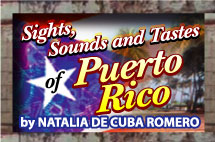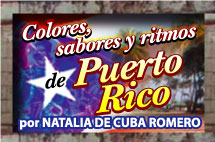|
 |
|
 |
|
Esta página no está disponible en español.
|

|
PUERTO RICO HERALD How A Sultana Skeptic Learned to Love Her Much-Maligned Little City By Natalia de Cuba Romero
|
 August 15, 2003
But I haven't been entirely fair. In fact, I haven't been fair at all. Mayagüez, the town where my mother (and my grandmother and all fourteen of her siblings) was born and raised, actually has a lot going for it in its own eclectic way. Some nifty architecture, a zoo, excellent bakeries, a lovely central plaza (populated by Ladies of Barcelona sculptures and frequented by the town's legendary cross dressers), a gorgeous theater and the riotous tropical foliage of the University of Puerto Rico's Mayaguez campus are just some of the attractions. And the town is making a super-human effort to shake its defeated backwater image and regain some of the regal elegance that made it La Sultana del Oeste (The Sultaness of the West) in the days of colonial Spain. Founded on September 18, 1760, the new town was strategically located on the site of what the local Taíno Indian called "Mayagüex" or place of the waters. On the bay facing the Mona Channel and the Dominican Republic (the Taínos had daily canoe ferry service between Puerto Rico and the DR, believe it or not) and surrounded by the rivers Yagüez and Añasco, Mayagüez had it all: fertile hills for coffee and fruit, a deep water port and an accessible location. So the money poured in and beautiful homes were built. You may notice that mayagüezanos (including me and more than half of the above-mentioned siblings of my grandmother) tend more to blue and green eyes than the rest of the Puerto Rican population. I've been told that it's because local farmers with no male heirs regularly kidnapped fair-skinned Spanish sailors by getting them stupefied on drink, taking them back home and convincing them as they recovered from their hangovers that inheriting a chunk of land, a lovely farmer's daughter and a new surname was infinitely preferable to returning to the austerities of the Spanish Armada and a landless future as a second son in Extremadura. True or not, I quite like the audaciousness attributed to my antecedents. And anyone who tries the infamous Sangría de Fido, created and still made in Mayagüez by the irascible Don Fido himself or drink India beer, knows that when it comes to getting stupefied, Mayagüez is where to look for Weapons of Mass Destruction. After a series of reversals in the 1800s due to fires, earthquakes, hurricanes and general bad luck, Mayagüez fell into decay. There was a flurry of building after the terrible earthquake of 1918 and you can still see the results in buildings like the 1923 Yagüez Theater on McKinley Street and 1926 City Hall on the plaza. Recently these buildings had fallen into disrepair, just as the major industry - the tuna canneries - has failed. Some edifices, like La Inmaculada, where my mother went to elementary school, were inexplicably and unforgiveably knocked down to create parking lots or low-budget department stores. And what beauty was left has been obscured by the most incredible cobwebs of power lines and telephone wires I've had the displeasure to see. But a change is coming. Cables are being buried, City Hall has been renovated, on the other side of Plaza Colón, the Cathedral of Our Lady of Candelaria is getting its towers back for the first time since the earthquake of 1918, the Yagüez Theater has had a facelift and there are coats of paint being splashed over numerous central buildings. One of the great things about Mayagüez is how the center of town bustles with mom and pop shops, even as the Mayagüez Mall flourishes. Great shoes at bargain basement prices are what I go there for, while the Plaza del Mercado on Casals Street (where my great grandfather had a stall in the early 1900s) is arguably the best on the island and features a lot of locally grown produce. Just outside the town the zoo has been redone and a jaguar was born there earlier this year. A stroll around the grounds of the Agricultural Extension center is a trip through tropical trees from all over the world. Make sure to look up; a flock of green parrots makes its home there. Fine dining is kind of a problem in this town. You can try El Estoril on Méndez Vigo for Old World style Portuguese and Spanish dishes with a creole twist or El Castillo in the Mayagüez Resort and Casino for good continental and local (visit Willie at the Terrace Bar on Thursdays for guitar music). And the bakeries are great. Ricomini and Franco, on either end of Méndez Vigo offer brazo Gitano jelly rolls and full meals. I prefer Ricomini (the roast turkey is fab as is the octopus salad) but Franco is the older and more venerable. For wine, head for the San Expedito Liquor Store on Santiago Palmer Street. And Mayagüez is the City of Mangoes. I've got a tree in my backyard, so I can vouch for their lush goodness. Unfortunately you'll have to wait until next June for the season (and the Festival del Mango), but it's worth a trip. In fact, much to my astonishment, this city on the rise is worth a trip right now. Consider this my apology for my woeful underappreciation of the past. The Data: Experimental Agricultural Station, 787-831-3435; Teatro Yagüez, 787-834-8585; Dr. Juan A Rivero Zoo, 787-834-8110; City Hall, 787-834-8585. Mayagüez has its own airport served by American Airlines/Eagle. The most recommended hotel in town is the Mayagüez Plaza on Méndez Vigo, a former residence of parish priests, 787-832-9191. The Mayagüez Resort & Casino is recommended, 787-832-3030. The Holiday Inn and Tropical Casino offers dancing several nights a week and is a social center as well as a good place to stay, 787-833-1100. Adventours (787-530-8311) and Tropical Beaches Tours (787-895-7736) can show you around.
Natalia de Cuba Romero is a freelance travel, food and arts writer. Her column, "Sights, Sounds & Tastes of Puerto Rico", appears weekly in the Puerto Rico Herald. She can be reached at nataliadecuba@optonline.net.
|